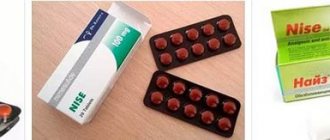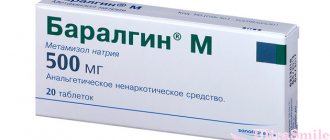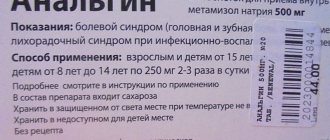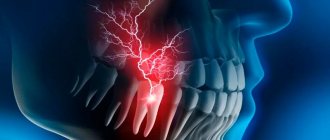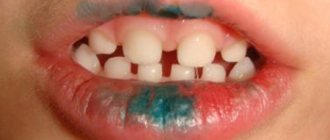Every person experiences pain at least once in their life. The reasons for its occurrence may be different, but the sensation of pain makes it clear that something is wrong in the body. Therefore, you should not ignore the signs of pain and put off solving the problem indefinitely; it is better to immediately seek help from a doctor, this will allow you to determine the causes of the pain. But this does not mean that you need to endure until the doctor finds the problem.
There are a huge number of painkillers that will very quickly relieve the symptoms of pain, but today we will look in detail at the cases in which Spazmalgon helps.
- 2 Indications for use of Spazmalgon
- 3 Recommendations for taking Spazmalgon
3.1 Side effects from taking Spazmalgon
Does Spazmalgon help with toothache?
The drug helps with toothache. Spazmalgon is part of the group of analgesics with a pronounced antispasmodic effect. The medicine has a combined composition and is therefore prescribed for pain syndromes of various origins.
The analgesic effect is provided due to the anti-inflammatory properties of the active ingredients. The substances that make up Spazmalgon reduce the sensitivity of pain receptors. In view of this, the medicine can be used for any acute pain, including dental pain.
How long does it take for the medicine to work?
The action of Spasmalgon develops quite quickly. On average, the tablet is absorbed within 25-40 minutes . The severity of the analgesic effect depends on the intensity of the pain and the dose taken. The effect lasts for an average of 4 hours.
Indications and restrictions
The drug is taken as an analgesic for pain that occurs due to spasm of smooth muscles (menstrual syndrome, renal colic, pain in the gastrointestinal tract). Spasmalgon also helps with toothache by inhibiting the activity of pain centers.
Unpleasant sensations in the teeth can occur for several reasons:
- Caries (tooth enamel is destroyed).
- Pulpitis (when destruction affects the pulp).
- Periodontitis (the process of inflammation has reached the tissues around the tooth).
Pulpitis
Despite the cause of pain in the oral cavity, Spazmalgon has a positive effect according to the mechanism discussed above.
Limitations to therapy are:
- Hypotension.
- Intestinal obstruction.
- Dysfunction of the liver, kidneys and bile duct.
- Problems with urination and prostate.
- Glaucoma.
- Bronchial diseases.
- Blood diseases.
- Arrhythmias.
- Individual intolerance to the components of the composition (tendency to allergies).
Glaucoma
The drug should not be taken as a pain reliever if the cause of the pain is a pathology requiring surgical intervention. The drug is not recommended for pregnant women, especially during the 1st and 3rd trimesters.
At the initial stage of pregnancy, the drug can cause fetal abnormalities and affect the formation of the organs of the unborn child. Admission in the 2nd trimester is possible only if the benefit to the mother significantly outweighs the harm to the child, and only under the supervision of a specialist.
The drug is allowed for children over 5 years of age, but with strict adherence to the dosage and maximum daily dose.
Compound
Spasmalgon is a combination drug.
The composition includes the following components:
- Metamizole sodium. A substance with anti-inflammatory properties of the non-steroidal group. It is characterized by a pronounced analgesic and anti-inflammatory effect. The component prevents the secretion of substances responsible for the formation of the inflammatory response, which in turn leads to a decrease in pain sensitivity in the affected area.
- Pitophenone hydrochloride. Antispasmodic component of the drug. The substance reduces smooth muscle tone. This helps relieve pain caused by spasms.
- Phenpiverinium bromide. It is an anticholinergic substance that has an antispasmodic effect. The component helps relax smooth muscles, thereby enhancing the analgesic effect.
The described components interact with each other, thereby enhancing the effect, which will help with toothache and also relieve pain after tooth extraction. Auxiliary components include gelatin, starch, magnesium stearate.
Indications for toothache
The use of Spazmalgon is advisable for a wide range of pathological phenomena accompanied by toothache.
Indications include:
- Increased sensitivity of teeth (due to violation of the integrity of the enamel)
- Formation of carious lesions
- Development of pulpitis against the background of caries
- Periodontal inflammation
- Infectious lesions of the periosteum
- Trigeminal nerve lesions
- Jaw injuries accompanied by toothache
Important to remember! Spazmalgon is used as an emergency remedy to relieve toothache. The medicine does not provide a long-term analgesic effect, since it does not relieve the cause of the pain syndrome.
Analogs
Today, there is a large selection of medications for dental pain among non-steroidal analgesics. The most common are:
Analgin is the most affordable analogue of Spazmalgon. Available without a prescription and at an affordable price. However, it is effective only for mild pain, which even dental drops can cope with.- Ibuprofen not only copes with pain, but also has an anti-inflammatory effect, therefore it is also used as a prevention of complications after tooth extraction.
- Diclofenac is able to fight even severe pain and inflammation.
- Ketanov is a potent drug based on ketorolac. Despite the strong and rapid effect after taking this drug, it has a number of disadvantages. This drug is not only expensive, but is also sold exclusively with a prescription from the attending physician, which makes the medication inconvenient if the tooth hurts at night.
Instructions for use
Spazmalgon is also available in ampoule format.
Taking any medications, especially analgesics, should be carried out in accordance with the instructions.
Detailed instructions are included with the medicine. Before taking it, it is important to make sure there are no contraindications or other possible restrictions.
Rules for taking Spazmalgon:
- If acute toothache occurs, take 1 or 2 tablets
- Tablets are taken orally
- The medicine should be taken with a sufficient amount of water
- It is forbidden to chew or dissolve Spazmalgon in the mouth.
Reference! If the patient is unable to fully take the medicine in tablet form, it can be replaced with an analogue in the form of an injection solution.
Dosage
To eliminate toothache, it is enough to take 1 or 2 tablets. The dosage is prescribed in accordance with the intensity of the pain syndrome and the suspected cause of its occurrence. For severe toothaches, it is recommended to take 2 tablets to completely get rid of the disease.
During the day, the patient is allowed to take no more than 6 Spazmalgon tablets. Thus, let's take 2 tablets three times a day. Between each dose there should be approximately the same time period.
With intense inflammation, the effectiveness of the described medicine may decrease. In this case, you should immediately seek dental care.
Important! Spazmalgon is not intended for long-term use. It is recommended to take the medicine no longer than 3 days. Otherwise, the risk of side effects increases.
Contraindications
More advantageous packaging – 50 Spazmalgon tablets.
Absolute contraindications include the following:
- Individual hypersensitivity
- Intestinal obstruction
- Functional gallbladder disorders
- Kidney or liver failure
- Pregnancy and lactation
- Leukopenia
- Anemia
- Severe respiratory tract diseases
- Cardiac disorders (arrhythmias, tachycardia)
- Age limit (children under 5 years old)
The drug is not recommended if the pain syndrome is of unknown origin and can be caused by serious illnesses requiring urgent surgical intervention.
The simultaneous use of Spazmalgon and any alcoholic beverages, sedatives, or medications containing Metamizole is strictly prohibited.
Contraindications to taking Spazmolgon
- The presence of surgical pathologies that require surgical intervention.
- Intestinal obstruction.
- Low blood pressure (hypotension).
- Failure is both renal and liver.
- Poor hematopoiesis, occurring with disturbances.
- Prostate adenoma, which is associated with urinary problems.
- Pregnancy, especially the first and third trimesters, as well as lactation.
- Severe disturbances in the functioning of the liver and bile ducts.
- Tachycardia, glaucoma, etc.
It should be remembered that should be used very carefully in patients who have bronchial asthma or other allergic diseases. In some cases, an exacerbation of the disease may occur.
Admission in childhood
In the form of tablets, Spazmalgon is allowed to be taken by children over 5 years old. The dosage regimen depends on the age of the child.
Method of administration in childhood:
- From 5 to 9 years – 1 tablet 2 times a day
- From 9 to 12 years – 1 tablet 3 times a day
- From 12 to 13 years – 1 tablet up to 4 times a day
- From 13 years – 1-2 tablets up to 6 tablets per day
It is recommended to consult a pediatrician before use. The duration of therapy should not be longer than 3 days. At least 6 hours should pass between each dose.
Use during pregnancy
During the period of bearing a child, taking Spazmalgon is prohibited. The drug is considered most dangerous in the 1st trimester, as it can provoke abnormalities in the development of internal organs.
Clinical studies refuting or confirming harm to the fetus in the 2nd and 3rd trimester have not been conducted. Taking Spazmalgon is not recommended during breastfeeding. The active components are characterized by increased penetrating ability, as a result of which they can enter the baby’s body through breast milk.
If necessary, when taking Spazmalgon, lactation is interrupted. Feeding may be resumed 48 hours after the last pill intake.
Advantages and disadvantages
Spazmalgon is characterized by the following advantages:
- Convenient release form
- Pronounced analgesic effect
- Long lasting
- Possibility of repeated admission within 3 days
- Possibility of admission in childhood
- Highly effective for pain syndromes of various origins
Unfortunately, despite the large number of advantages, the medicine has a number of disadvantages. The most significant include a wide range of contraindications, which is why not all patients can use this medicine. In addition, taking the medication can cause unpleasant side effects.
These include:
- Heartburn
- Dry mouth
- Nausea and vomiting
- Dizziness
- Shortness of breath
- Tachycardia
- Change in urine color
- Allergic skin rashes
- Anaphylactic reactions
The potential for side effects indicates the need for strict adherence to dosages and timing of administration.
Possible side effects and overdose
Like all medications, Spazmalgon has a number of possible side effects, which most often occur due to dosage violations and in case of long-term use of the drug.
Symptoms of adverse reactions and overdose:
dry mouth;- nausea and vomiting;
- exacerbation of gastrointestinal diseases;
- allergic reactions (rash, itching, urticaria);
- increased blood pressure and arrhythmia;
- headaches and dizziness;
- fatigue and irritability;
- urinary disturbance (frequent or infrequent urge).
Sometimes, as a result of taking Spazmalgon, the urine turns red, but this is not considered a pathology. All of the above symptoms occur only in cases of drug overdose or when the injection form of release is used. When using the tablet form of release, side effects occur extremely rarely.
Cost and analogues
The price of the drug Spazmalgon varies depending on the manufacturer and the number of tablets in the package. The cost of a package of 10 tablets is 136 rubles . The price for 20 tablets is from 144 rubles , and for 50 tablets – from 300 rubles .
If necessary, Spazmalgon can be replaced with a drug with a similar effect. The most popular analogues are presented in the table.
| Name | Price | Short description |
| Spazgan | 249 rubles per pack of 100 tablets | It is a direct analogue of Spasmalgon. Has identical active ingredients. It is used for various pain syndromes, including to eliminate toothache. |
| Took | 51 rubles per pack of 10 tablets | Antispasmodic based on Metamizole in combination with Pitophenone hydrochloride and fenpiverinium. It has a pronounced analgesic, antipyretic and anti-inflammatory effect. |
| Maxigan | 326 rubles per pack of 100 tablets | Antispasmodic drug with similar active ingredients. It is used for dental headaches, syndromes caused by inflammatory processes in tissues, rheumatism, injuries, postoperative pain. |
| Spasmalin | 118 rubles per pack of 20 tablets | Direct analogue of Spazmalgon. Has pronounced analgesic activity. Allowed to take up to 4 times a day. |
| Spasmoblock | 105 rubles per pack of 20 tablets | Prescribed to relieve pain caused by smooth muscle spasms and inflammatory processes. It is advisable to take for mild or moderate syndromes. |
General information about the drug
Spazmalgon is a complex drug that has analgesic, antipyretic and antispasmodic effects.
Consists of metamizole sodium, pitofenone and fenpiverinium bromide. Spazmalgon is characterized by rapid action, which occurs 15-20 minutes after oral administration and 7 minutes after injection. Available in the form of white tablets and solution for injection in ampoules.
Composition of the drug
Used to relieve moderate pain of various etiologies. For example, for pain in joints, muscles, headaches, renal colic, premenstrual syndrome and in other cases when the occurrence of unpleasant sensations is associated with spasm of the smooth muscles of internal organs.
The drug is sold at an affordable price. A package of 10 tablets costs an average of 160 rubles, and a package of ampoules of 5 ml each will cost approximately 350 rubles. Sold without a prescription.
Reviews
In this section you can read user reviews about the drug Spazmalgon, the advantages and disadvantages of taking the presented drug, and effective analogues.
Spasmalgon is a potent combination drug that has a pronounced analgesic effect. The drug is prescribed to eliminate pain of various origins, including toothache. Administration must be carried out in full accordance with the prescribed dosages, taking into account the patient’s age, pain intensity, and possible contraindications.
